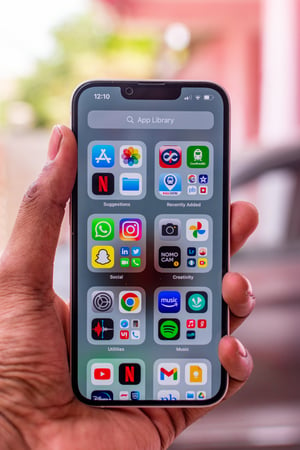There’s plenty of buzz right now about AI, thanks to the Generative AI revolution, sparked by ChatGPT and other recent developments. But did you know you’ve already been using AI for years or maybe even decades? And did you know that AI has been using your data for just as long?
If you thought that what you watch, eat, wear, and even who you date isn’t already deeply influenced by AI, you’re in for a slight shock. Sometimes it’s obvious, often it is not. This article (the first in a series of three) illustrates how AI affects us and how we can affect it across our lives.

Tracking the Impact of AI Throughout Our Lives
Let’s imagine we could accelerate ourselves from early education through to retirement in the next few minutes, and understand the influence of AI on us (and vice versa) through the kinds of phone apps commonly used at each life stage.
1. Toddlers:
The first app we meet is a simple game for toddlers: bright colors, pleasing sounds. Surely it’s not sophisticated enough to involve AI, right? Well, a lot depends on the business model: If the app is free, is it supported by advertising? In the post-cookie era, more and more identification of users will rely on recognizing patterns of behavior (and categorizing users) to create profiles that can inform advertisers what they should market to us and that is AI.
2. School Age:
The next set of apps are paid for by our school, so they are ad free. AI is used as part of the purpose of the application … to learn, or at least to encourage attention. Some of our lessons are through the school app and it uses the camera to detect whether we are engaged. When we are not, it reminds us (and tells the teacher) … sound fanciful? This use of AI is already commonplace in some schools in China.
3. In the Workforce:
After leaving education and getting a job, it’s time to spend our own time and money on what we enjoy, and what better examples than Netflix and Uber Eats. The use of AI to recommend content or food is very well-known … based on what we watch and like, algorithms predict what else we might like next, given the viewing/eating histories of those similar to us. But AI is everywhere else in these apps too, working out where chapter breaks occur, automating subtitle creation, and now even influencing the direction of new content development.
4. Investments:
For any leftover disposable income, well hopefully we’re saving it, and perhaps using an app from our bank that makes investment suggestions. Some of these are simple ads, like any other ad, but AI-powered investment is becoming much more tangible: Products already in the market allow you to hand the reins to a machine (with some human oversight), give it some starting instructions, and let it get to work reading news, watching graphs, investing on your behalf.
5. Dating/Relationships:
It might be nice to spend your rapidly accumulating wealth on a special someone … if you can find them, and today there are MANY apps where that person could be hiding. Given just how many swipes it would take to match everyone to everybody else, it’s simply not possible to run these apps without AI making educated guesses. But pause for a moment: What’s in it for the app developer should you find that special someone? Maybe they don’t want their AI to be too good at matching, too fast…
6. Health/Aging:
At some point, you have aged enough to notice your health, especially if you weren’t taking care of it before. And while there is no shortage of apps for calling a doctor, or getting a prescription, we are not yet in the age of mass, personalized medicine. Surely that data from our phones about our sleep, our physical activity, maybe even what food we order, is going somewhere. Wouldn’t it be great if it were used to prevent illness in the first place?
So, What Do We Learn From the Pervasiveness of AI?
These examples show a few things: First, AI is already here at every life stage, and it would be hard to imagine reversing that. Would Netflix be any fun at all if you had to search manually through all its content?
Second, these examples show that how AI influences us can be very direct and obvious, as in the case of the curiously satisfying takeaway recommendation, or indirect, simply using our interactions with an app to improve how it runs. And finally, it pays to keep in mind that old saying: If the product is free, you and your data might be the product.
Given you cannot avoid AI, it’s important to understand the rewards and risks, and how you as an individual, the teams you work with, and wider society can balance those. Learn more about that topic in the next article of this series.




